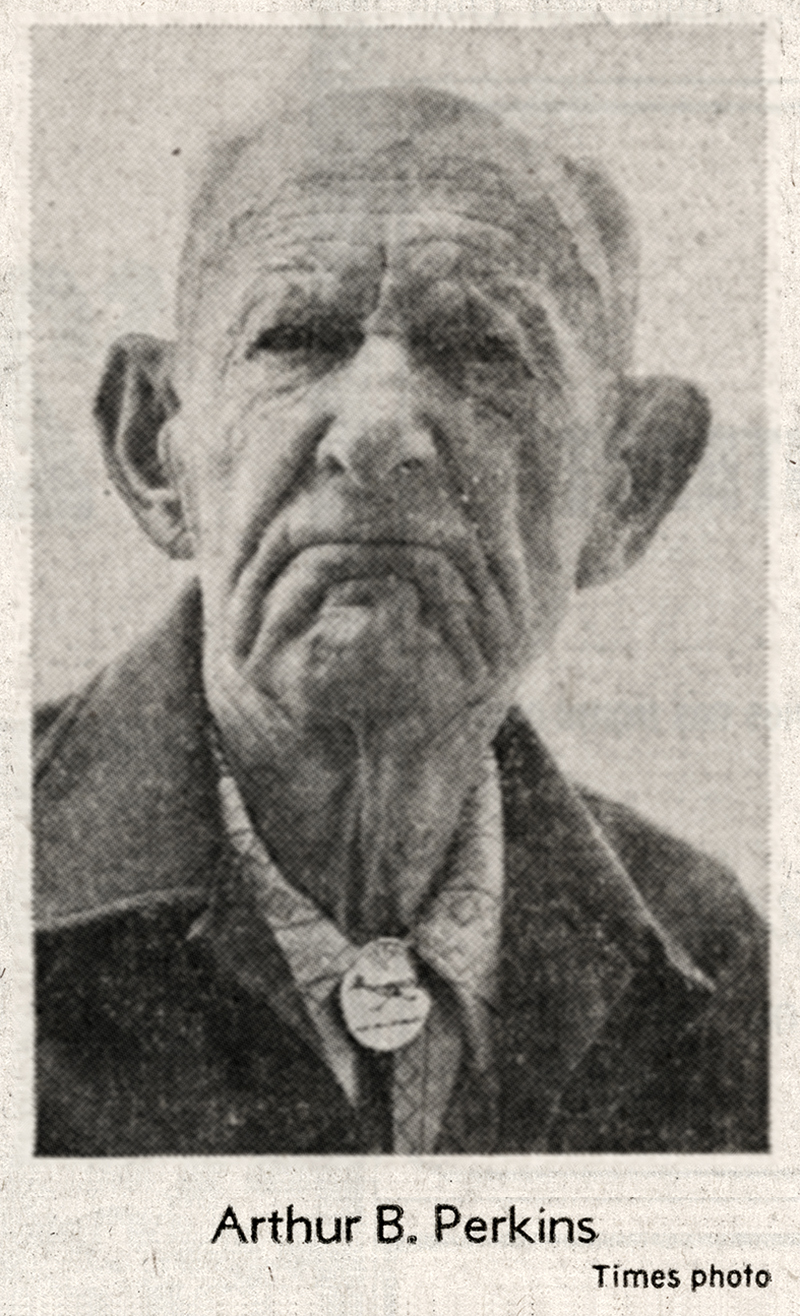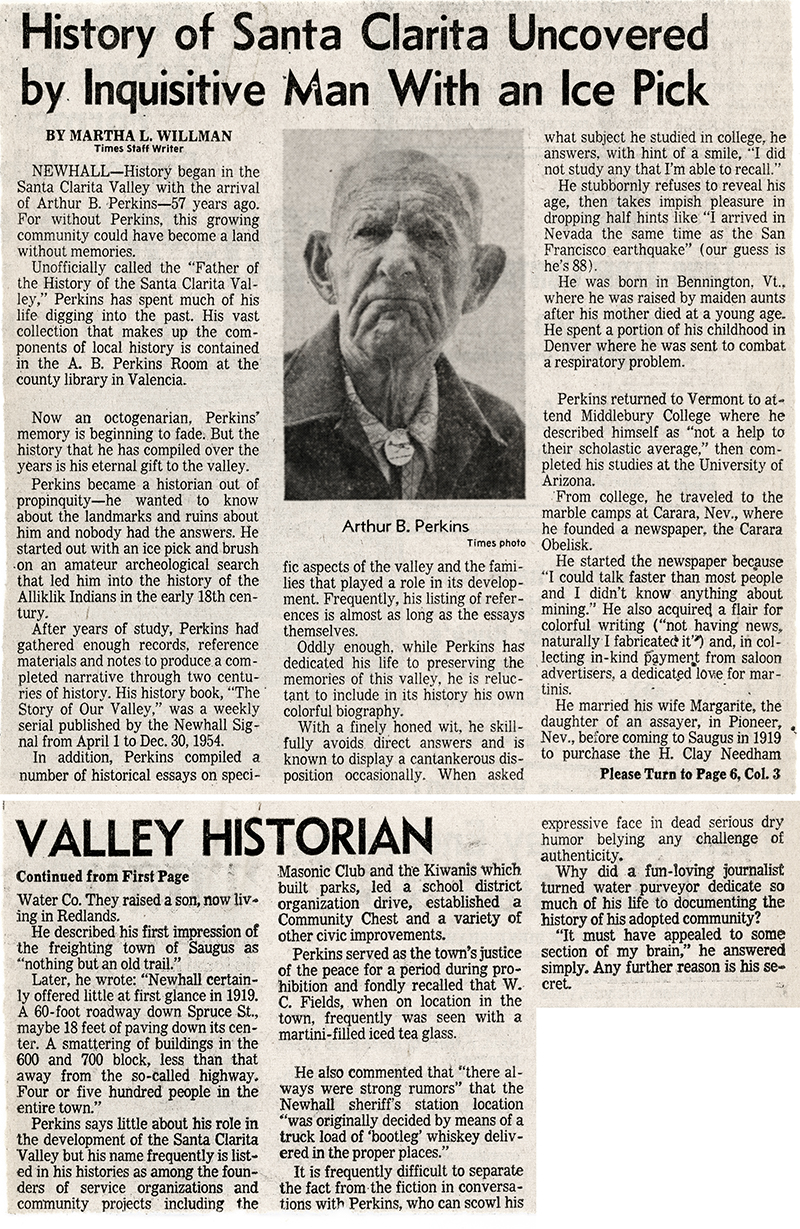History of Santa Clarita Uncovered by Inquisitive Man With an Ice Pick.
|
NEWHALL — History began in the Santa Clarita Valley with the arrival of Arthur B. Perkins — 57 years ago. For without Perkins, this growing community could have become a land without memories. Unofficially called the "Father of the History of the Santa Clarita Valley," Perkins has spent much of his life digging into the past. His vast collection that makes up the components of local history is contained in the A.B. Perkins Room at the county library in Valencia. >> Here's what happened with the Perkins collection at the Valencia Library. Now an octogenarian, Perkins' memory is beginning to fade. But the history that he has compiled over the years is his eternal gift to the valley. Perkins became a historian out of propinquity — he wanted to know about the landmarks and ruins about him and nobody had the answers. He started out with an ice pick and brush on an amateur archeological search that led him into the history of the Alliklik Indians [now known as Tataviam] in the early 18th century. After years of study, Perkins had gathered enough records, reference materials and notes to produce a completed narrative through two centuries of history. His history book, "The Story of Our Valley," was a weekly serial published by the Newhall Signal from April 1 to Dec. 30, 1954. In addition, Perkins compiled a number of historical essays on specific aspects of the valley and the families that played a role in its development. Frequently, his listing of references is almost as long as the essays themselves. Oddly enough, while Perkins has dedicated his life to preserving the memories of this valley, he is reluctant to include in its history his own colorful biography. With a finely honed wit, he skillfully avoids direct answers and is known to display a cantankerous disposition occasionally. When asked what subject he studied in college, he answers, with hint of a smile, "I did not study any that I'm able to recall." He stubbornly refuses to reveal his age, then takes impish pleasure in dropping half hints like "I arrived in Nevada the same time as the San Francisco earthquake" (our guess is he's 88). He was born in Bennington, Vt., where he was raised by maiden aunts after his mother died at a young age. He spent a portion of his childhood in Denver where he was sent to combat a respiratory problem. Perkins returned to Vermont to attend Middlebury College where he described himself as "not a help to their scholastic average," then completed his studies at the University of Arizona. From college, he traveled to the marble camps at Carara [sic: Carrara], Nev., where he founded a newspaper, the Carara Obelisk. He started the newspaper because "I could talk faster than most people and I didn't know anything about mining." He also acquired a flair for colorful writing ("not having news, naturally I fabricated it") and, in collecting in-kind payment from saloon advertisers, a dedicated love for martinis. He married his wife Margarite, the daughter of an assayer, in Pioneer, Nev., before coming to Saugus in 1919 to purchase the H. Clay Needham Water Co. They raised a son, now living in Redlands. He described his first impression of the freighting town of Saugus as "nothing but an old trail." Later, he wrote: "Newhall certainly offered little at first glance in 1919. A 60-foot roadway down Spruce St., maybe 18 feet of paving down its center. A smattering of buildings in the 600 and 700 block, less than that away from the so-called highway. Four or five hundred people in the entire town." Perkins says little about his role in the development of the Santa Clarita Valley but his name frequently is listed in his histories as among the founders of service organizations and community projects including the Masonic Club and the Kiwanis which built parks, led a school district organization drive, established a Community Chest and a variety of other civic improvements. Perkins served as the town's justice of the peace for a period during prohibition and fondly recalled that W.C. Fields, when on location in the town, frequently was seen with a martini-filled iced tea glass. He also commented that "there always were strong rumors" that the Newhall sheriff's station location "was originally decided by means of a truck load of 'bootleg' whiskey delivered in the proper places." It is frequently difficult to separate the fact from the fiction in conversations with Perkins, who can scowl his expressive face in dead serious dry humor belying any challenge of authenticity. Why did a fun-loving journalist turned water purveyor dedicate so much of his life to documenting the history of his adopted community? "It must have appealed to some section of my brain," he answered simply. Any further reason is his secret.
Original newspaper clipping in photo file.
|


